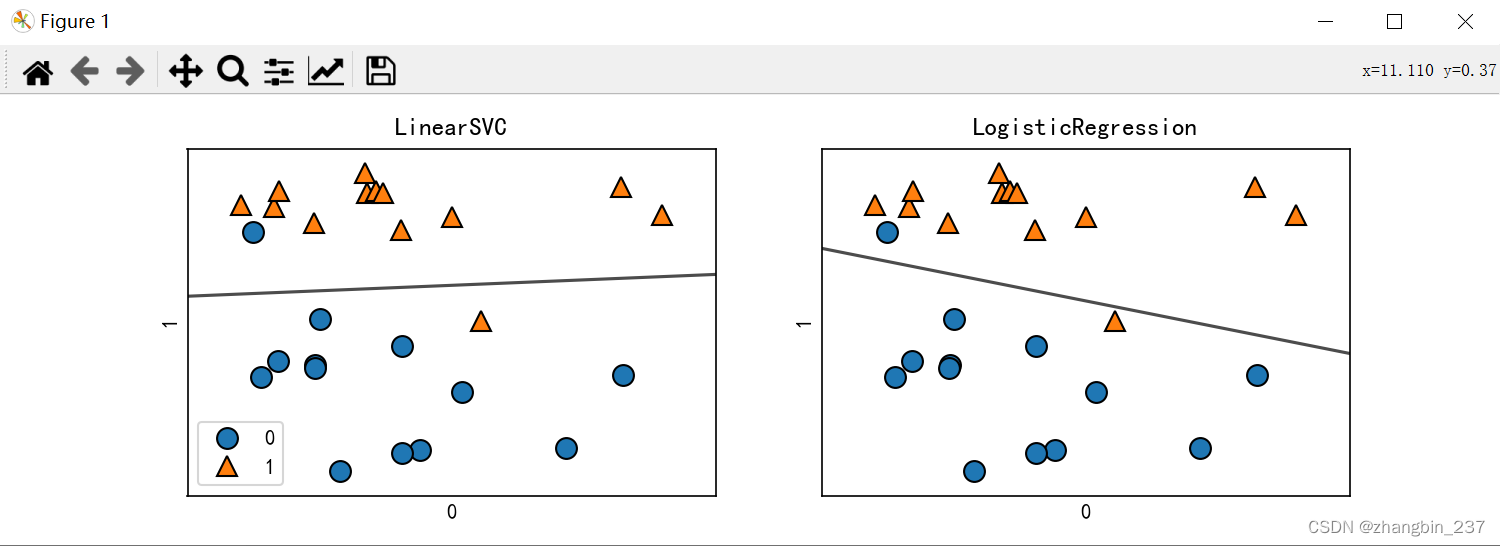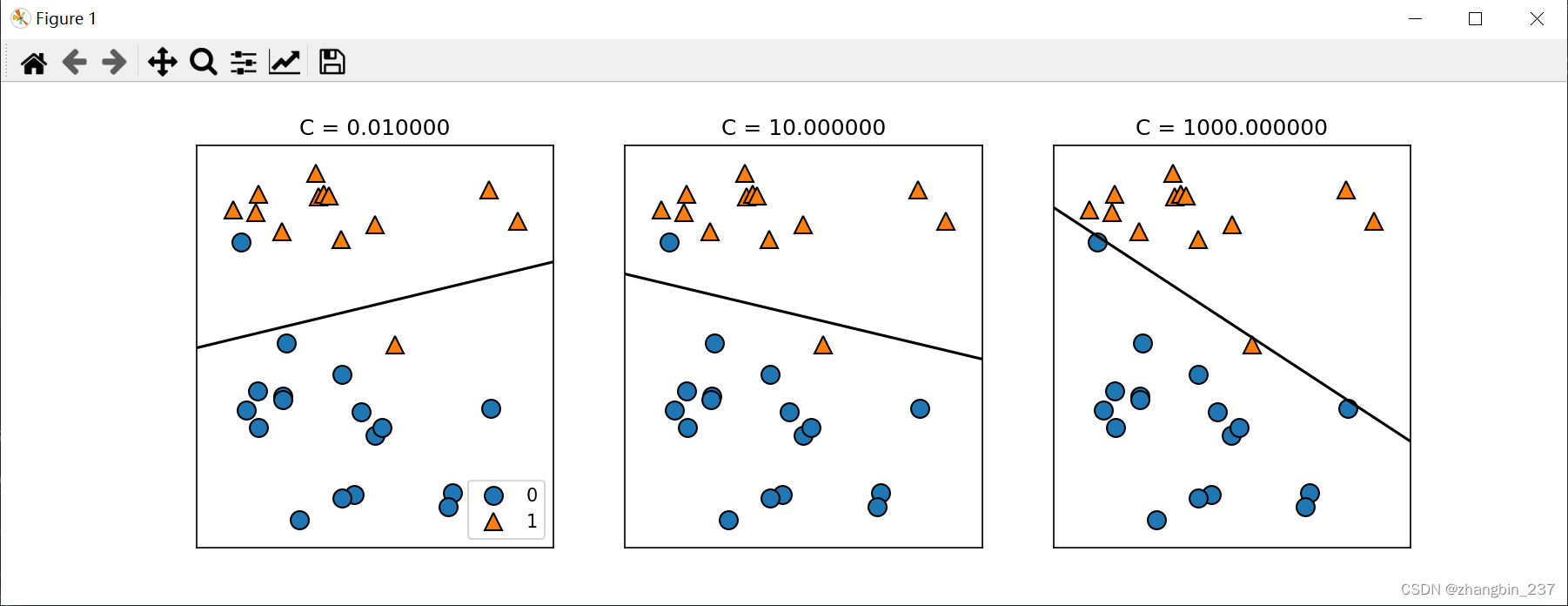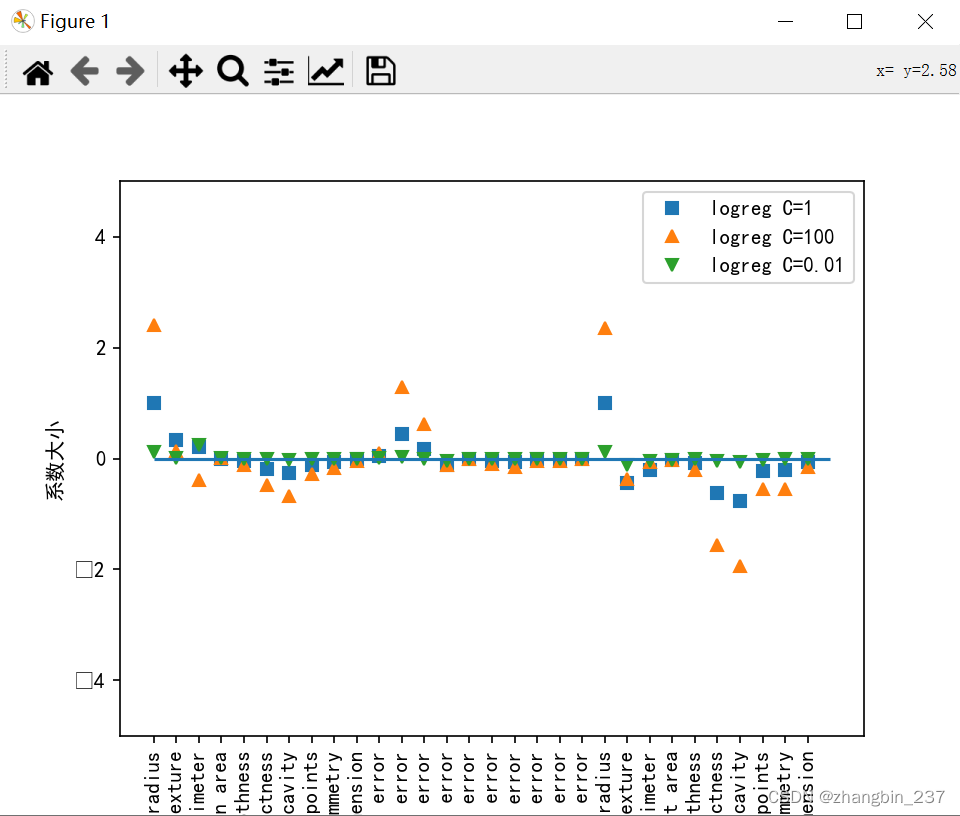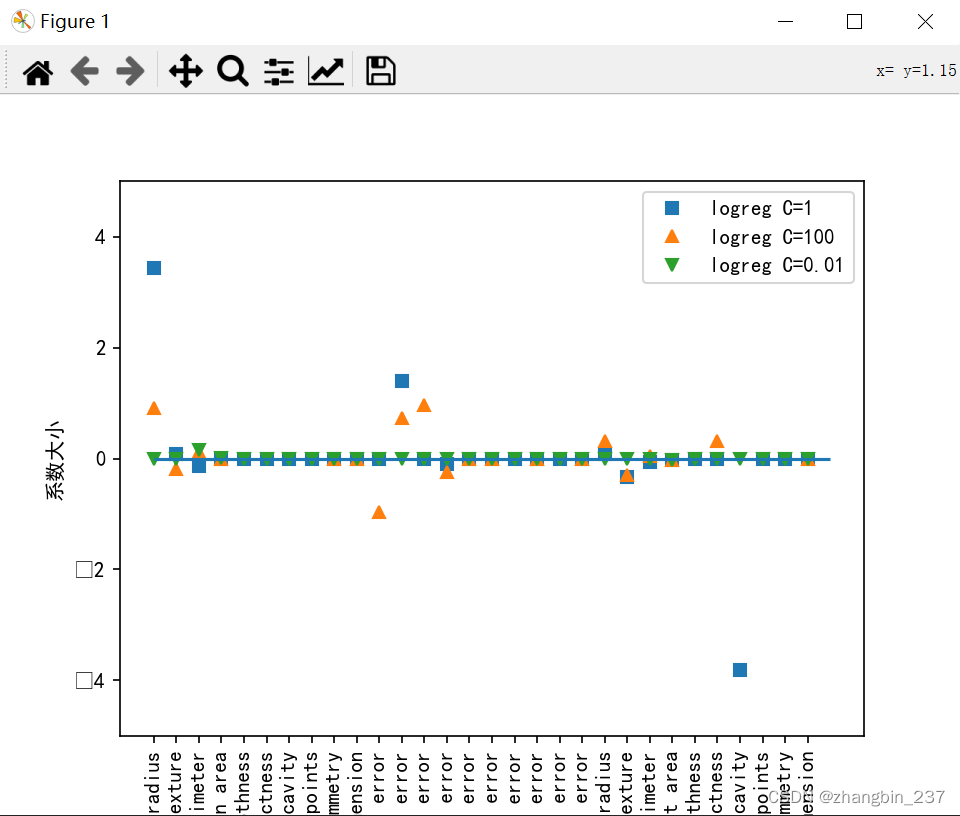线性模型也广泛用于分类问题,对于二分类问题,可以用以下公式进行预测:
y=w[0]*x[0]+w[1]*x[1]+…………+w[p]*x[p]+b>0
公式与现行回归的公式非常类似,但没有返回特征的加权求和,而是为预测设置了阈值。如果函数值小于0,就预测类别-1,否则预测类别+1。
对于用于回归的线性模型,输出y是特征的线性函数,是直线、平面或者超平面。对于用于分类的线性模型,决策边界是输入的线性函数。
学习线性模型有很多算法,主要区别在于:
1、系数与截距的特定组合对训练数据拟合好坏的度量方法
2、是否使用正则化,以及使用哪种正则化。
最常见的线性分类算法是Logistic回归和线性支持向量机(线性SVM),用到的类分别是linear_model.LogisticRegression、svm.LinearSVC。
对两种分类算法的模型用在forge数据集上,并对决策边界可视化:
import mglearn.datasets
from sklearn.linear_model import Ridge,LinearRegression,Lasso,LogisticRegression
from sklearn.svm import LinearSVC
import matplotlib.pyplot as plt
plt.rcParams['font.sans-serif']=['SimHei']
X,y=mglearn.datasets.make_forge()
fig,axes=plt.subplots(1,2,figsize=(10,3))
for model,ax in zip([LinearSVC(),LogisticRegression()],axes):
clf=model.fit(X,y)
mglearn.plots.plot_2d_separator(clf,X,fill=False,eps=0.5,ax=ax,alpha=.7)
mglearn.discrete_scatter(X[:,0],X[:,1],y,ax=ax)
ax.set_title('{}'.format(clf.__class__.__name__))
ax.set_xlabel('0')
ax.set_ylabel('1')
axes[0].legend()
plt.show()

图中黑线上方的数据点会被划分为类别1,下方的数据点会被划分为类别0。
两种模型默认使用L2正则化,就像岭回归。
对于LogisticRegression和LinearSVC,决定正则化强度的权衡参数为C,C越大,正则化越弱,也就是C越小,训练集拟合越好,C越大,系数向量越接近于0。

对于多维数据集,用于分类的线性模型会非常强大,考虑更多特征时,避免过拟合就更重要。
from sklearn.datasets import load_breast_cancer
from sklearn.model_selection import train_test_split
from sklearn.linear_model import Ridge,LinearRegression,Lasso,LogisticRegression
cancer=load_breast_cancer()
X_train,X_test,y_train,y_test=train_test_split(
cancer.data,cancer.target,stratify=cancer.target,random_state=42
)
logreg=LogisticRegression().fit(X_train,y_train)
print('C=1的训练集score:{:.3f}'.format(logreg.score(X_train,y_train)))
print('C=1的测试集score:{:.3f}'.format(logreg.score(X_test,y_test)))
logreg_100=LogisticRegression(C=100).fit(X_train,y_train)
print('C=100的训练集score:{:.3f}'.format(logreg_100.score(X_train,y_train)))
print('C=100的测试集score:{:.3f}'.format(logreg_100.score(X_test,y_test)))
logreg_001=LogisticRegression(C=0.01).fit(X_train,y_train)
print('C=0.01的训练集score:{:.3f}'.format(logreg_001.score(X_train,y_train)))
print('C=0.01的测试集score:{:.3f}'.format(logreg_001.score(X_test,y_test)))
结果输出:
C=1的训练集score:0.944
C=1的测试集score:0.965
C=100的训练集score:0.955
C=100的测试集score:0.958
C=0.01的训练集score:0.934
C=0.01的测试集score:0.930可以看到,C=1(默认值)时,性能就比较好了,训练集和测试集的精度在95%左右,但非常相近,所以模型很可能是欠拟合的,C=100时,得到了更高的训练集精度,C=0.01时精度下降,有可能存在过拟合。
对于系数的影响,可视化可以看到:
from sklearn.datasets import load_breast_cancer
from sklearn.model_selection import train_test_split
from sklearn.linear_model import Ridge,LinearRegression,Lasso,LogisticRegression
import matplotlib.pyplot as plt
plt.rcParams['font.sans-serif']=['SimHei']
cancer=load_breast_cancer()
X_train,X_test,y_train,y_test=train_test_split(
cancer.data,cancer.target,stratify=cancer.target,random_state=42
)
logreg=LogisticRegression().fit(X_train,y_train)
logreg_100=LogisticRegression(C=100).fit(X_train,y_train)
logreg_001=LogisticRegression(C=0.01).fit(X_train,y_train)
#,penalty ='l1',solver='liblinear'
plt.plot(logreg.coef_.T,'s',label='logreg C=1')
plt.plot(logreg_100.coef_.T,'^',label='logreg C=100')
plt.plot(logreg_001.coef_.T,'v',label='logreg C=0.01')
plt.xticks(range(cancer.data.shape[1]),cancer.feature_names,rotation=90)
plt.hlines(0,0,cancer.data.shape[1])
plt.ylim(-5,5)
plt.xlabel('index')
plt.ylabel('系数大小')
plt.legend()
plt.show() 
可以看到,更强的正则化使得系数更倾向于0,但不正好等于0,如果用L1正则化,约束模型就只使用少数几个特征,






















 7573
7573











 被折叠的 条评论
为什么被折叠?
被折叠的 条评论
为什么被折叠?








